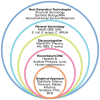Designing vaccines for the twenty-first century society
- PMID: 24478777
- PMCID: PMC3899546
- DOI: 10.3389/fimmu.2014.00012
Designing vaccines for the twenty-first century society
Abstract
The history of vaccination clearly demonstrates that vaccines have been highly successful in preventing infectious diseases, reducing significantly the incidence of childhood diseases and mortality. However, many infections are still not preventable with the currently available vaccines and they represent a major cause of mortality worldwide. In the twenty-first century, the innovation brought by novel technologies in antigen discovery and formulation together with a deeper knowledge of the human immune responses are paving the way for the development of new vaccines. Final goal will be to rationally design effective vaccines where conventional approaches have failed.
Keywords: glyco-conjugate; structural vaccinology; technologies; vaccination; vaccine design.
Figures


References
-
- Willis NJ. Edward Jenner and the eradication of smallpox. Scott Med J (1997) 42:118–21 - PubMed
Publication types
LinkOut - more resources
Full Text Sources
Other Literature Sources

